About History of Jaipur
What to Know About History of Jaipur
Jaipur’s predecessor state became the dominion of dhundhar or dausa, based in 1093 via dullah rai, additionally appeared as dulha rao. The country became called amber among the fourteenth century and 1727. In that 12 months, a brand new capital changed into built and named jayapura, while the kingdom become once renamed as jaipur. Below you can get all the information of History of Jaipur.
Founder Of Jaipur – History of Jaipur
Jaipur (The PINK CITY of India) founded on 18 November 1727 by Jai Singh II, the Raja of Amer who ruled from 1699 to 1743. The city is named by Maharaja Jai Singh II who was the primary organizer of this city. He was a Rajput and ruled the Rajasthan region from 1699 and 1744.The city was originally named as Jainagara which in Sanskrit meant as the ‘city of victory’.
Later it was named as ‘pink city’ in the early 20th century by the British.Jaipur, later became the capital of the Indian state of Rajasthan.After his 70 years of reign in Amer(1688-1758), Maharaja Jai Singh II planned to shift his capital 11 km away to Jaipur to accommodate the growing population.The Statue Circle in Jaipur is reminiscent of the rich history and architecture of Jaipur,and it is considered as a tribute to the founder of Jaipur – Maharaja Sawai Jai Singh II.A tour of Jaipur would not be complete if the person does not watch a snake charmer on the street. The snake charmers are found in different locations in Jaipur but are mostly found in the bazaars.
Local Foods in Jaipur – History of Jaipur
Tourists are also advised to taste local food. Tourists are also advised to taste local food. The area boasts of delicious vegetarian dishes that are given a distinct taste. Jaipur is the capital of Rajasthan and it has been popularized With the Name of ‘Pink City’.When Sawai Ram Singh ruled Jaipur, the city was painted with pink color to welcome the Prince of Wales in 1876.The city was planned according to Indian Vastu shastra by Vidyadhar Bhattacharya in 1727.
The city has three gates facing east, west, and north. The gate in the eastern part is called Suraj pol (sun gate), the gate in the western part is called Chand pol (moon gate) and the gate in the northern part of the city faces the ancestral capital of Amer.Jaipur Typical dishes are include Dal Baati Churma, Missi Roti, Gatte ki Sabzi, Ker Sangri, Makke ki Ghat, Bajre ki Ghat and Bajre ki Roti.The language of jaipur is Rajasthani.
Dhundhari, Marwari, Hindi.The popular folk dance is a Ghoomar.The Major festivals celebrated in Jaipur are Makar Sankranti,Gangaur, Elephant Festival, Holi, Diwali, Vijayadashami, Teej, Eid, Mahavir Jayanti and Christmas. Jaipur was painted pink in 1853 to welcome the arrival of the Prince of Wales. Since then, Jaipur became known as the Pink City. Over the years, Jaipur developed into a commercial city. Shops began to rise in the streets. Colleges and hospitals also became common in Jaipur.
The Rulers of Jaipur (Pinkcity) – History of Jaipur
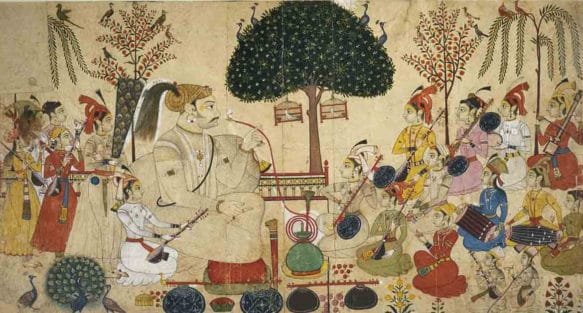
Post Sawai Jai Singh era, the town was dominated by many Hindu rulers. Here is the list of most rulers of Jaipur(PinkCity) Sawai Pratap Singh (1764 – 1803), Sawai Ram Singh II (1835 to 1880), Madho Singh II (1861 – 1922) and Sawai Man Singh II (1911 – 1970).
The city was attacked again and again by neighboring warriors, Marathas. except for most of its history, Jaipur stayed beneath the rule of Rajputs. it had been one in all the few components of the country that ne’er came beneath the rule of British, who left India in 1947.
Why Jaipur also known by Pink City

In 1876, the Prince of Wales and Queen Victoria were to pay a visit to the Republic of India. Pink signifies cordial reception, thus to awaken life the essence of hospitable words, “Padharo Mahrey Desh”, prince Ram Singh got the town covered this stunning color. The color, Terracotta Pink adds seven stars to the pride of this majestic Jaipur City. Even nowadays if you visit Jaipur, you may realize the historical gates and squares that have currently become bazaars possessing the color of cordial reception and has plain-woven itself into the history of Jaipur.
History of Jaipur Before Independence
Though the rulers had higher relationships with the East Indies Company the town was named Rajputana and was administered and supervised by British people throughout the freedom struggle.
History of Jaipur Post Independence
After independence within the year, 1956, town Beautiful city Jaipur became the capital of the dazzling state Rajasthan.
The bewitching historical town Jaipur stands as an entranceway for those people who like to get pleasure from the charming ambiance and royal flavor.
History echoes within the variety of Ancient Monuments
Every wall you see within the Jaipur city can cause you to marvel concerning the sumptuousness of Jaipur once it involves design. every Monument listed below has been roaring in maintaining its vitality and individuation until the date and contributes during a huge way to the history of Jaipur.
(1) Hawa Mahal
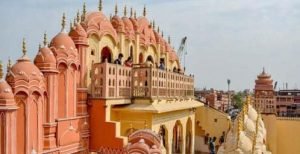
Also called The Palace of Winds, Hawa Mahal portrays the excellence of mind and wonder. it had been designed by prince Sawai Pratap Singh who was illustrious for his brilliance. Purdah System was followed within the Royal Families enduring that the females weren’t allowed to move with strangers. Therefore, to stay the ladies of Royal Families connected with the outer world, the Hawa Mahal was designed. This gave them a chance to catch a variety of processions and events through the windows. Within the type of the development of this heritage building, a step towards the social upliftment of ladies was taken by prince Sawai Pratap Singh. Hawa Mahal is also big proof of History of Jaipur.
(2) Amber Fort
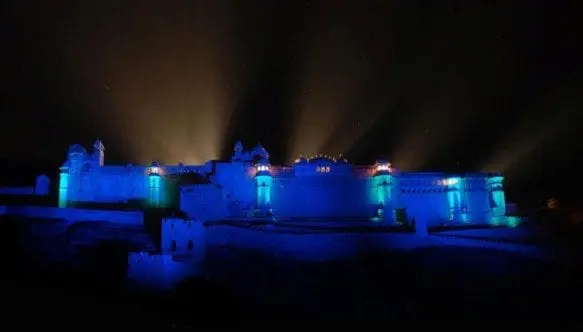
Amber fort is Birthplace to the princess of Amber Jodha Bai, the Fort was designed by Raja Man Singh throughout 967 Ce. The development, renovation, and enlargement of the Fort were contacted an amount of one hundred-a hundred and fifty years. Jai Man Singh I took the task of increasing the fort over Aravalli vary.
(3) Nahargarh Fort
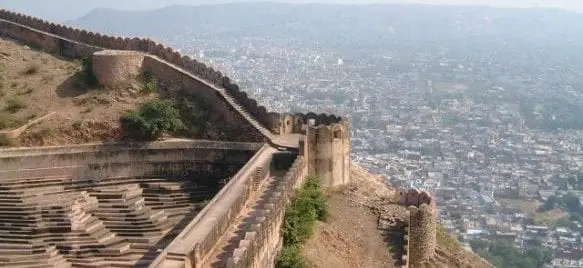
Literally that means ‘An Abode to Tigers’, Nahargarh Fort was designed by prince Jai Singh II in 1734. The techniques of its construction are derived from the Indo-European design. Formerly, the palace was created as an area of retreat however within the later periods, the Fort witnessed necessary treaties with Marathas. what is more, throughout the Indian Mutiny of 1857, Sawai Ram Singh shifted the Europeans and therefore the British Resident’s mate to the current Fort so as to produce protection from the outer riots. Nahargarh Fort is also big proof of History of Jaipur.
May you Like this:- Government Jobs of Rajasthan
(4) Jaigarh Fort
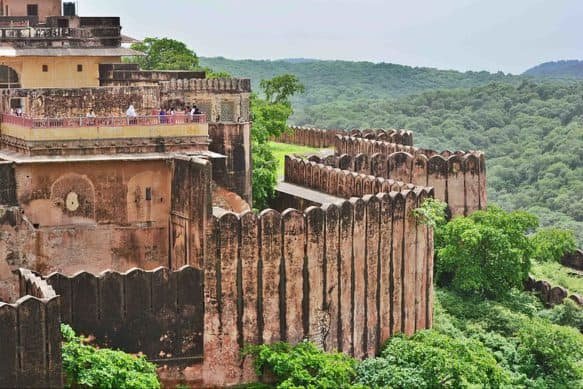
Stand anyplace within the city of Amber, and you may simply spot the endless walls of this fort. it had been a construction designed to guard the Amber Fort in 1726 by Sawai Jai Singh. The fort was the main cannon manufactory throughout the Mughal dynasty due to an abundance of ore mines in its domain. the massive tank which was used for storing half a dozen million gallons of water had chambered at a lower place that was accustomed hide the loot. Also, the fort could be home to the world’s largest cannon, Jaivana cannon.
(5) Jal Mahal
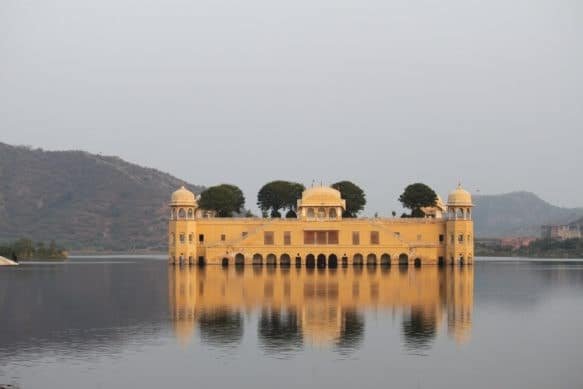
The Water Palace is located fully faraway from the hubbubs of the town within the middle of Sagar Lake. within the earlier period, it acted as a house for Maharajas. With five floors in-built it, only the highest floor remains higher than the water level. it’s a treat to one’s eye once looked upon throughout the evening time. The Jal Mahal stands as another attractive example of the thought of the city’s rulers.
(6) City Palace

Built between 1729 and 1732, the city Palace is presently home to the royal line of Jaipur. The palace bestowing to its magnificence includes of Chandra Mahal and Mubarak Mahal. it’s a mix of gardens, courtyards, temples, and plenty of different richly designed buildings. simple fraction of the Jaipur town comes beneath the geographical influence of the majestic town Palace. Man Singh II was the last maharajah of Jaipur to rule from the Chandra Palace as at that time Jaipur got incorporate with the Indian Union. Also, nowadays the Palace has not solely become a place to witness historical valour however additionally one among the simplest choices for destination weddings in Bharat. City palace is also big proof of History of Jaipur.
(7) Jantar Mantar
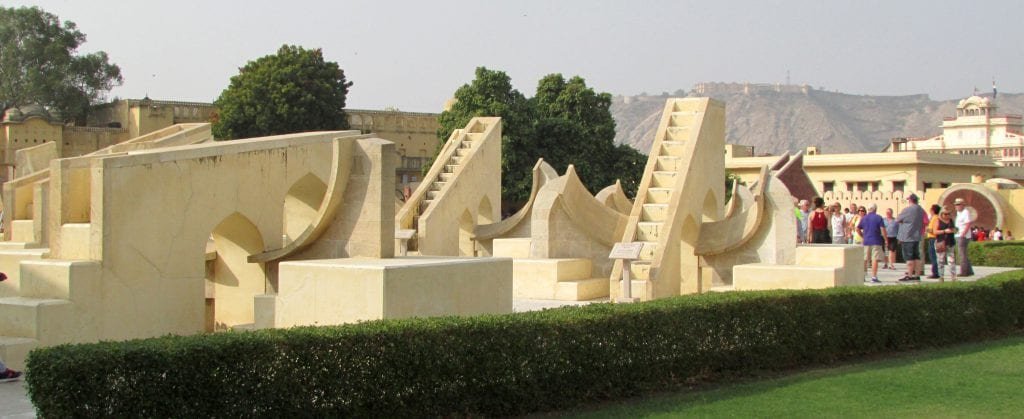
Jantar Mantar is that the largest astronomical observatory among the five that was designed by Sawai Jai Singh. The heritage attraction personifies the knowledge possessed by the previous Rajputana King. It includes of 19 fine arts astronomical instruments. the large timepiece or The Samrat Yantra settled at the peak of twenty-seven m was accustomed to predict seasons and movement of planets.
It appears that people in Jaipur understand well regarding conserving their historical ardor. thus visit Jaipur for an amazing expertise of its undaunted history and skill the history of Jaipur all told its splendor.
Must Read: Culture of Jaipur
If you Like this article on history of Jaipur then share it with your friends and family members to appreciate our work and help other people. And if Some information about history of Jaipur is wrong then please give suggestions by commenting below.
